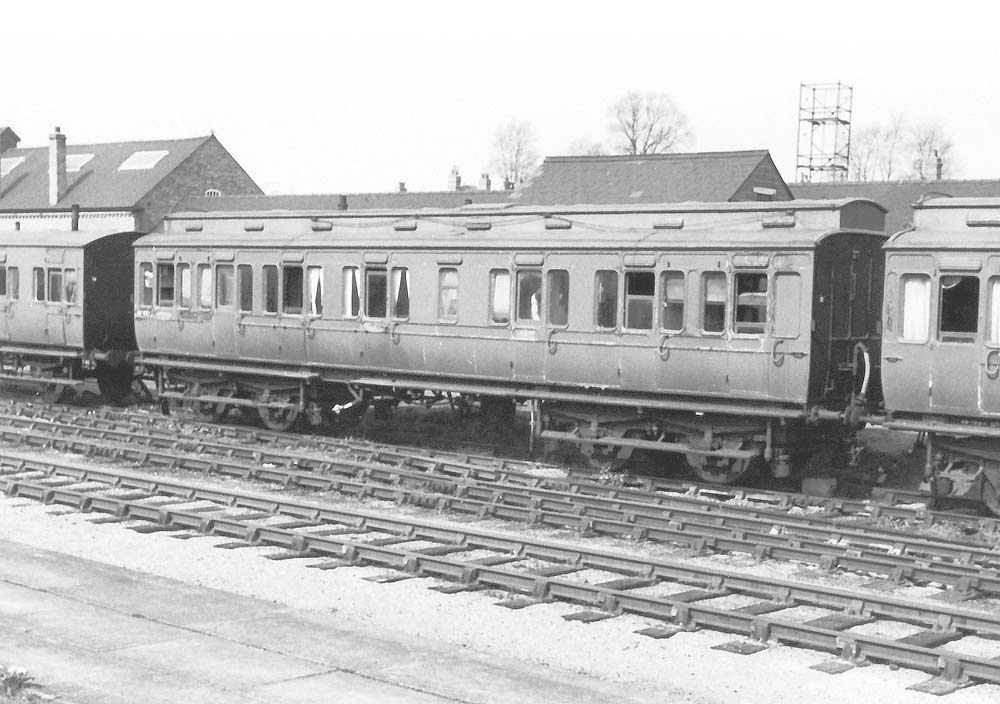 |
|
GWR Route: Banbury to Wolverhampton
Solihull Station: gwrs2630
 |
Ex-Great Western Railway Camping Coach No W9972 in the up
sidings at Solihull Station on Saturday 19th April 1952. This 46 foot, 6 inch
long clerestory tri-composite coach was built at Swindon to diagram E27 in May
1890 as one of six coaches constructed under lot 544 and was numbered No 581 (a
further five diagram E27 coaches were constructed under lot 470). The diagram
E27 coach had three third class, two second class and two first class
compartments. There was no corridor but in the centre of the coach were two
lavatories each with access to one of the adjacent first class compartments.
They were constructed as convertible coaches with an eight foot wide carriage
body on broad gauge bogies and with the end of the broad gauge in sight, narrow
gauge bogies were substituted on No 581 in May 1892 and the coach renumbered No
1050. In 1907 the Great Western Railway renumbered its coaching stock giving
each coach a four digit number with the first figure indicating the type and as
a composite, this coach became No 7050. These diagram E27 coaches were
originally fitted with lighting from flat flame gas burners, but incandescent
gas lighting was installed in July 1908. The coach was withdrawn from revenue
earning passenger traffic and officially condemned in January 1935.
In June 1935, the condemned coach was converted to a type C
(eight berth) Camp Coach and became No 9972. This was one of fourteen new type
C Camp Coaches in 1935, which included five converts from condemned diagram E27
coaches - The others were Nos; 9971 (ex 7046), 9973 (ex 7052), 9974 (ex 7054)
and 9975 (ex 7055). All were given a similar internal arrangement; one of the
lavatories was retained as a cloak room, with access from the central communal
area, adjacent to this area was the kitchen with cupboards, sink, stove and
oven, while at the coach ends were three bedrooms (one with bunkbeds). The
layout allowed all the rooms to be accessed without leaving the coach, with
external doors being provided only from the communal area and kitchen. In the
1930s the cost of hiring a type C Camp Coach was £4 per week, plus an
obligation to purchase eight rail tickets. The seasonal holiday locations of
Camp Coach No 9972 are not known, but Camp coach holidays ceased in 1940
following the start of the Second World War in the previous year.
Camp Coaches were in demand as temporary accommodation by
the Government and Military, as well as the Railway Company. Several were used
by the Signal & Telegraph Department as emergency wireless vans with one
modified Camp Coach being allocated to each Division in case critical
telecommunication locations were damaged by bombing. These emergency wireless
vans were equipped with Marconi trans-receivers and a portable aerial mast. No
9972 was known to be with the Signal & Telegraph Department at Cheltenham
on 15th July 1942 and after the war the coach was retained by the Department.
The coach was known to be at Radyr in September 1949. The W prefix to the
number was added by British Railway and coach No W9969 was finally condemned in
May 1956.
This photograph is displayed courtesy of the HMRS
(Historical Model Railway Society) and copies can be ordered directly from them
using the link HERE, quoting reference ABW610.
Robert Ferris
 back back

|
